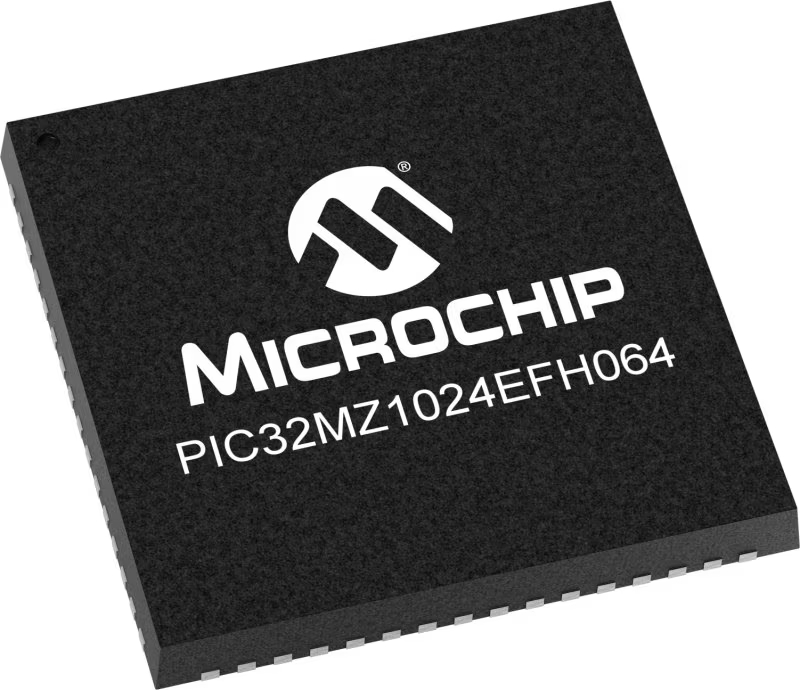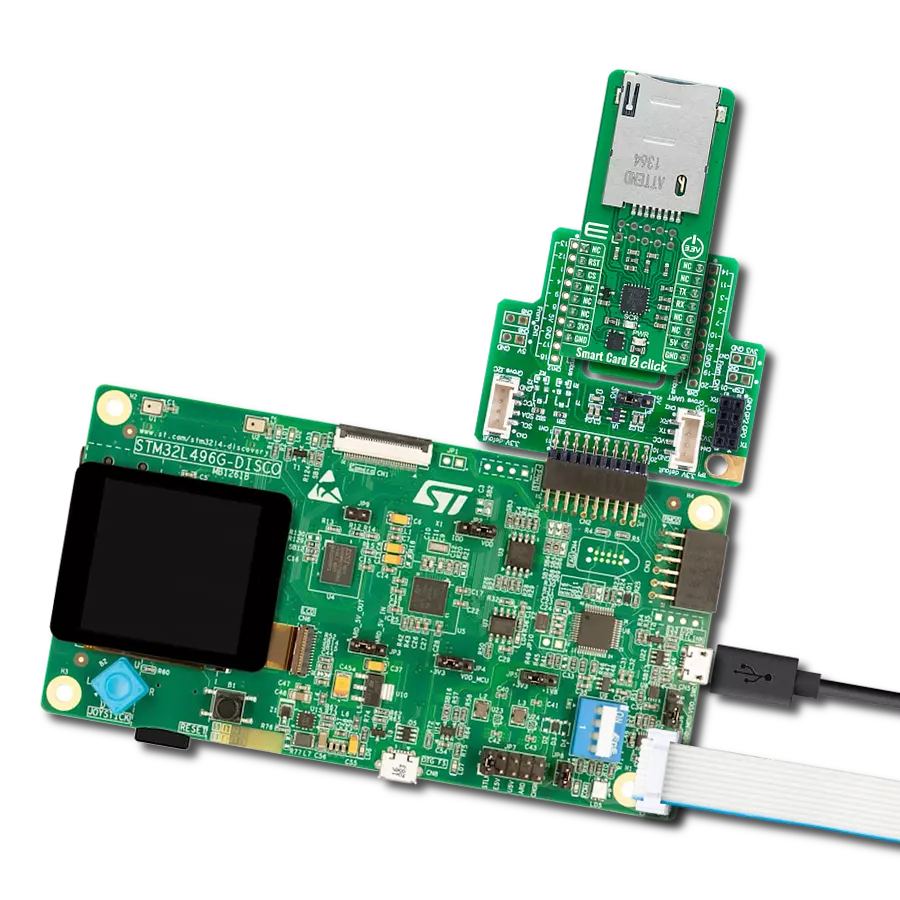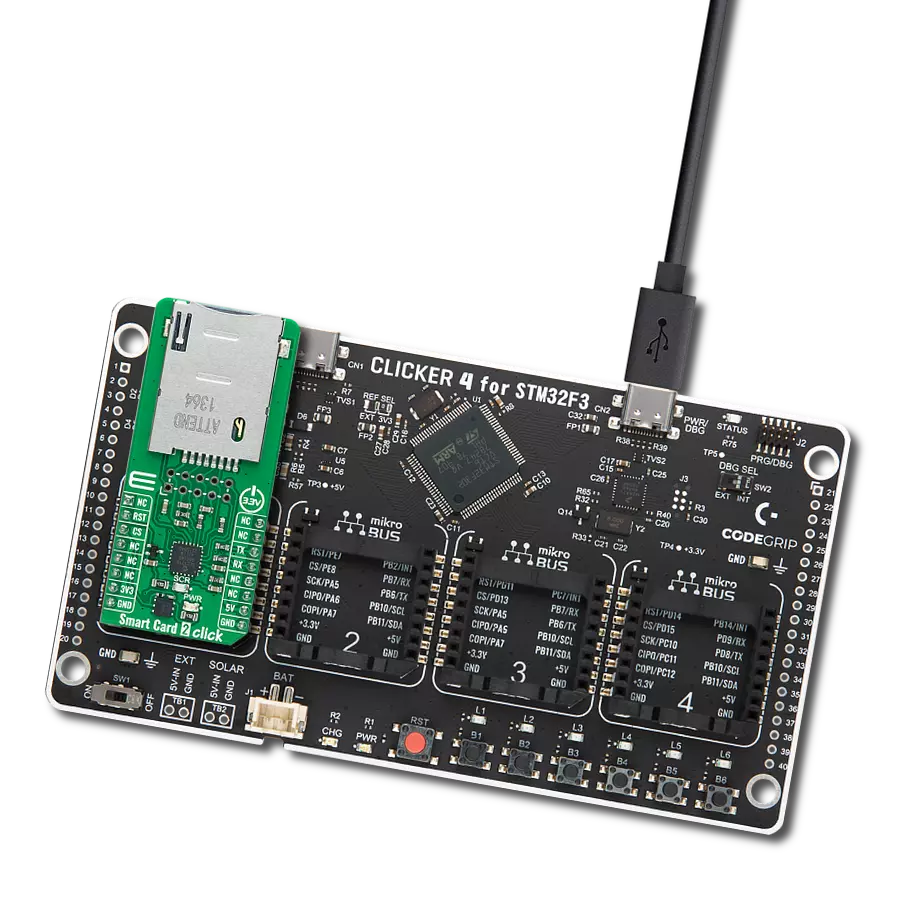探索市场上最先进的智能卡读卡器,提供无与伦比的保护和易用性。
A
A
硬件概览
它是如何工作的?
Smart Card 2 Click基于Microchip的SEC1210,这是一款高性能单芯片智能卡控制器,具有UART接口。SEC1210由增强型集成8051 CPU控制,所有芯片外围设备通过SFR或XDATA寄存器空间进行访问和管理。此外,它完全符合现行的智能卡标准(ISO7816、EMV和PC/SC),满足所有通信比特率要求,并支持高达826Kbps的提议比特率。SEC1210电源单元在内部调节和切换,支持所有5V、3V和1.8V智能卡(分别为A类、B类和C类)。SEC1210采用
TrustSpan™技术,使数字系统能够安全地通信、处理、传输和存储信息。板载的卡托支持2FF智能卡的数据处理。额外的外部连接器还允许处理标准的1FF卡,使其非常适合电子过程,如个人识别、访问控制(物理和逻辑访问)、认证等。此Click板™通过UART接口与MCU通信,使用常见的UART RX/TX,默认配置下操作速率为115200 bps,以传输和交换数据。激活/停用过程本身可以通过软件实现,但也支持硬件停用,当卡被拔出时,确保所需的序列无论是否参
与软件都能实现。此外,Smart Card 2 Click还具有通用复位功能,连接到mikroBUS™插槽的RST引脚,这使模块进入复位状态,而标记为SRC的黄色LED指示灯代表智能卡状态指示灯。此LED的闪烁表明智能卡数据处理正在进行中。此Click板™可以与3.3V和5V的MCU一起操作,而SEC1210仅使用来自mikroBUS™电源轨的5V作为其主要电源。然而,此Click板™配备了包含函数和示例代码的库,可用作进一步开发的参考。
功能概述
开发板
PIC32MZ Clicker 是一款紧凑型入门开发板,它将 Click 板™的灵活性带给您喜爱的微控制器,使其成为实现您想法的完美入门套件。它配备了一款板载 32 位带有浮点单元的 Microchip PIC32MZ 微控制器,一个 USB 连接器,LED 指示灯,按钮,一个 mikroProg 连接器,以及一个用于与外部电子设备接口的头部。得益于其紧凑的设计和清晰易识别的丝网标记,它提供了流畅且沉浸式的工作体验,允许在任
何情况下、任何地方都能访问。PIC32MZ Clicker 开 发套件的每个部分都包含了使同一板块运行最高效的必要组件。除了可以选择 PIC32MZ Clicker 的编程方式,使用 USB HID mikroBootloader 或通过外部 mikroProg 连接器为 PIC,dsPIC 或 PIC32 编程外,Clicker 板还包括一个干净且调节过的开发套件电源供应模块。USB Micro-B 连接可以提供多达 500mA 的电流,这足以操作所有板载和附加模块。所有
mikroBUS™ 本身支持的通信方法都在这块板上,包 括已经建立良好的 mikroBUS™ 插槽、重置按钮以及若干按钮和 LED 指示灯。PIC32MZ Clicker 是 Mikroe 生态系统的一个组成部分,允许您在几分钟内创建新的应用程序。它由 Mikroe 软件工具原生支持,得益于大量不同的 Click 板™(超过一千块板),其数量每天都在增长,它涵盖了原型制作的许多方面。
微控制器概述
MCU卡片 / MCU

建筑
PIC32
MCU 内存 (KB)
1024
硅供应商
Microchip
引脚数
64
RAM (字节)
524288
使用的MCU引脚
mikroBUS™映射器
“仔细看看!”
Click board™ 原理图

一步一步来
项目组装
软件支持
库描述
该库包含 Smart Card 2 Click 驱动程序的 API。
关键功能:
smartcard2_send_ccid- 该函数使用UART串行接口发送CCID命令消息smartcard2_read_ccid- 该函数使用UART串行接口读取CCID响应或事件消息smartcard2_icc_power_on- 该函数通过执行ICC上电命令激活卡片。设备将以包含ICC ATR(复位应答)消息的数据块进行响应
开源
代码示例
完整的应用程序代码和一个现成的项目可以通过NECTO Studio包管理器直接安装到NECTO Studio。 应用程序代码也可以在MIKROE的GitHub账户中找到。
/*!
* @file main.c
* @brief Smart Card 2 Click Example.
*
* # Description
* This example demonstrates the use of Smart Card 2 Click board by checking
* the SIM card presence and activating the card on insert. The card should respond
* with an ATR (Answer to Reset) message.
*
* The demo application is composed of two sections :
*
* ## Application Init
* Initializes the driver and enables the device.
*
* ## Application Task
* Reads and parses all CCID messages received from the device. Checks the SIM card presence
* and activates it if it's inserted. The card should respond with an ATR (Answer to Reset) message.
* All data is being logged on the USB UART where you can track their changes.
*
* @note
* This example doesn't parse ATR messages.
* There are some online ATR parsers which could be used for decoding those messages.
* For example: https://smartcard-atr.apdu.fr/
*
* @author Stefan Filipovic
*
*/
#include "board.h"
#include "log.h"
#include "smartcard2.h"
static smartcard2_t smartcard2;
static log_t logger;
static uint8_t icc_status = SMARTCARD2_ICC_ABSENT;
/**
* @brief Smart Card 2 display ccid message function.
* @details This function parses the CCID message and updates the icc_status in the end.
* The results will be displayed on the USB UART.
* @param[in] ccid : CCID message to be parsed.
* See #smartcard2_ccid_t object definition for detailed explanation.
* @return None.
* @note None.
*/
static void smartcard2_display_ccid_message ( smartcard2_ccid_t ccid );
void application_init ( void )
{
log_cfg_t log_cfg; /**< Logger config object. */
smartcard2_cfg_t smartcard2_cfg; /**< Click config object. */
/**
* Logger initialization.
* Default baud rate: 115200
* Default log level: LOG_LEVEL_DEBUG
* @note If USB_UART_RX and USB_UART_TX
* are defined as HAL_PIN_NC, you will
* need to define them manually for log to work.
* See @b LOG_MAP_USB_UART macro definition for detailed explanation.
*/
LOG_MAP_USB_UART( log_cfg );
log_init( &logger, &log_cfg );
log_info( &logger, " Application Init " );
// Click initialization.
smartcard2_cfg_setup( &smartcard2_cfg );
SMARTCARD2_MAP_MIKROBUS( smartcard2_cfg, MIKROBUS_1 );
if ( UART_ERROR == smartcard2_init( &smartcard2, &smartcard2_cfg ) )
{
log_error( &logger, " Communication init." );
for ( ; ; );
}
log_info( &logger, " Application Task " );
}
void application_task ( void )
{
smartcard2_ccid_t ccid = { 0 };
if ( SMARTCARD2_OK == smartcard2_read_ccid ( &smartcard2, &ccid ) )
{
smartcard2_display_ccid_message ( ccid );
}
if ( SMARTCARD2_ICC_PRESENT == icc_status )
{
log_printf( &logger, " Activating card... \r\n" );
smartcard2_icc_power_on ( &smartcard2, SMARTCARD2_POWER_SEL_3V );
Delay_ms ( 100 );
}
}
int main ( void )
{
/* Do not remove this line or clock might not be set correctly. */
#ifdef PREINIT_SUPPORTED
preinit();
#endif
application_init( );
for ( ; ; )
{
application_task( );
}
return 0;
}
static void smartcard2_display_ccid_message ( smartcard2_ccid_t ccid )
{
log_printf( &logger, "---------------------------------\r\n" );
switch ( ccid.type )
{
case SMARTCARD2_EVT_NOTIFY_SLOT_CHANGE:
{
log_printf( &logger, " Message type: Slot change\r\n" );
if ( SMARTCARD2_CARD_ABSENT == ccid.payload[ 0 ] )
{
icc_status = SMARTCARD2_ICC_ABSENT;
}
else if ( SMARTCARD2_CARD_PRESENT == ccid.payload[ 0 ] )
{
icc_status = SMARTCARD2_ICC_PRESENT;
}
break;
}
case SMARTCARD2_CTRL_NACK:
{
log_printf( &logger, " Message type: NACK\r\n" );
log_printf( &logger, " Command not acknowledged\r\n" );
break;
}
case SMARTCARD2_RSP_SLOT_STATUS:
{
log_printf( &logger, " Message type: Slot status\r\n" );
log_printf( &logger, " Slot number: 0x%.2X\r\n", ( uint16_t ) ccid.slot_num );
log_printf( &logger, " Seq number: 0x%.2X\r\n", ( uint16_t ) ccid.seq_num );
log_printf( &logger, " Status: 0x%.2X\r\n", ( uint16_t ) ccid.spec_bytes[ 0 ] );
icc_status = ccid.spec_bytes[ 0 ] & SMARTCARD2_ICC_STATUS_MASK;
log_printf( &logger, " Error: 0x%.2X\r\n", ( uint16_t ) ccid.spec_bytes[ 1 ] );
log_printf( &logger, " Clock status: " );
switch ( ccid.spec_bytes[ 2 ] )
{
case SMARTCARD2_CLK_STATUS_RUNNING:
{
log_printf( &logger, "Running\r\n" );
break;
}
case SMARTCARD2_CLK_STATUS_STATE_L:
{
log_printf( &logger, "Stoped in state L\r\n" );
break;
}
case SMARTCARD2_CLK_STATUS_STATE_H:
{
log_printf( &logger, "Stoped in state H\r\n" );
break;
}
default:
{
log_printf( &logger, "Unknown\r\n" );
break;
}
}
break;
}
case SMARTCARD2_RSP_DATA_BLOCK:
{
log_printf( &logger, " Message type: Data Block\r\n" );
log_printf( &logger, " Payload size: %lu\r\n", ccid.payload_size );
log_printf( &logger, " Slot number: 0x%.2X\r\n", ( uint16_t ) ccid.slot_num );
log_printf( &logger, " Seq number: 0x%.2X\r\n", ( uint16_t ) ccid.seq_num );
log_printf( &logger, " Status: 0x%.2X\r\n", ( uint16_t ) ccid.spec_bytes[ 0 ] );
icc_status = ccid.spec_bytes[ 0 ] & SMARTCARD2_ICC_STATUS_MASK;
log_printf( &logger, " Error: 0x%.2X\r\n", ( uint16_t ) ccid.spec_bytes[ 1 ] );
log_printf( &logger, " Chain parameter: 0x%.2X\r\n", ( uint16_t ) ccid.spec_bytes[ 2 ] );
if ( ccid.payload_size )
{
log_printf( &logger, " Payload (ATR data as response to power on):\r\n" );
for ( uint32_t cnt = 0; cnt < ccid.payload_size; cnt++ )
{
log_printf( &logger, " %.2X", ( uint16_t ) ccid.payload[ cnt ] );
}
log_printf( &logger, "\r\n" );
}
break;
}
default:
{
log_printf( &logger, " Message type: 0x%.2X\r\n", ( uint16_t ) ccid.type );
log_printf( &logger, " Payload size: %lu\r\n", ccid.payload_size );
log_printf( &logger, " Slot number: 0x%.2X\r\n", ( uint16_t ) ccid.slot_num );
log_printf( &logger, " Seq number: 0x%.2X\r\n", ( uint16_t ) ccid.seq_num );
log_printf( &logger, " Spec bytes: 0x%.2X, 0x%.2X, 0x%.2X\r\n", ( uint16_t ) ccid.spec_bytes[ 0 ],
( uint16_t ) ccid.spec_bytes[ 1 ],
( uint16_t ) ccid.spec_bytes[ 2 ] );
if ( ccid.payload_size )
{
log_printf( &logger, " Payload:\r\n" );
for ( uint32_t cnt = 0; cnt < ccid.payload_size; cnt++ )
{
log_printf( &logger, " 0x%.2X", ( uint16_t ) ccid.payload[ cnt ] );
if ( 7 == cnt % 8 )
{
log_printf( &logger, "\r\n" );
}
}
log_printf( &logger, "\r\n" );
}
break;
}
}
if ( SMARTCARD2_ICC_ABSENT == icc_status )
{
log_printf( &logger, " ICC status: ABSENT\r\n" );
}
else if ( SMARTCARD2_ICC_PRESENT == icc_status )
{
log_printf( &logger, " ICC status: PRESENT\r\n" );
}
else if ( SMARTCARD2_ICC_ACTIVE == icc_status )
{
log_printf( &logger, " ICC status: ACTIVE\r\n" );
}
log_printf( &logger, "---------------------------------\r\n\n" );
}
// ------------------------------------------------------------------------ END































